Introduction
How Can Comics Contribute to Peace-Building?
Corpus of Peace-Building Comics Treating the Arab-Israeli Conflict
Israeli Contributions to Peace-Building
Palestinian Contributions to Peace-Building
Conclusion
The first step of real peace is to know the other side, its culture and creativity.
(Mahmoud Darwish)
Introduction
Contributions to peace-building through comics is probably not the first thing that most people would associate with this medium, as unfortunately it still has – even 60 years after the publication of Seduction of the Innocent1 - somehow the reputation to be an unserious, and sometimes even violence-glorifying part of popular culture which is loved by but not appropriate for children who are judged to be better off reading ‘real’ books.2
But besides the fact that comics (the term comics is to be understood and henceforth used as a hypernym for any kind of sequential art3 regardless of its provenance, publishing form, or content4) have never exclusively been produced for a juvenile readership, comics “are a language, with their own grammar, syntax and punctuation”5 resulting in “a unique and powerful form of communication.”6 As the specific language of the medium comics results in other forms of narration,7 comics offer a different access to information, memory, history, ideas or ideals as other media. Surely in great part thanks to Art Spiegelman’s Maus,8 that won the Pulitzer Prize in 1992, not only has a great number of other gifted authors/artists treated in comics difficult and complex issues of historical, political, social and of other nature since then;9 the medium itself has also been more widely accepted as appropriate for dealing with such contents. This is not only reflected by considerable academic attention and research,10 but also by the fact that, for example, the highly esteemed French social economic journal «Le Monde Diplomatique» has decided to publish, in November 2010, a comics format issue of its content,11 and that since 2006 Marjane Satrapi’s Persepolis is part of the cadet’s curriculum in the U.S. Military Academy at West Point.12
One sub-genre of these socio-historical and political comics is the Arab-Israeli Conflict-Comic (hereafter called AIC-Comics).13 Although some of these comics have been published before Maus,14 most of them have15 after Joe Sacco’s Palestine.16 There could be several reasons for this: it could be because of this journalistic/documentary pioneering work in this field; or because in Israel and Palestine (as well as in the adjacent countries) the comic industry and culture are of lesser importance,17 if compared to other countries; it could also be simply because of the great significance of this conflict in general. Be as it may, AIC-Comics are not only produced by authors from the countries directly involved, but also by many who are from other parts of the world. Among them one can find American,18 Maltese-American,19 French and Belgian,20 Italian21 and Korean22 authors. Some of them have a Jewish religious and/or cultural background, others do not.23
Regardless of their country of production, but also regardless of the type of narration (documentary/ journalistic approach, or fiction), most AIC-Comics contain, not very surprisingly, some kind of political message either in favor of the Israelis24 or – and this is much more frequent – in favor of the Palestinians.25 In some of these works, also in supposedly more “objective” documentary/journalistic ones (in Sacco’s books, too), I could even detect elements of propaganda to make the reader incline towards the Palestinian side.26
Why there is such an uneven allocation in favor of the Palestinian side in AIC-Comics is an interesting question. One reason for it could be the political opinion of the authors.27 But this question, as well as probably entailing a discussion on left-wing anti-Semitism and anti-Zionism,28 merits a much deeper analysis which cannot be accomplished here, as the focus of this article is on AIC-Comics that contribute to peace-building.
This ‘sub-genre’ of AIC-Comics is, to date, still very small and to my knowledge, it has just as little been researched as AIC-Comics in general.29 However, there are a number of articles that have been published in the last couple of years focusing on specific works, authors or aspects of the corpus of AIC-Comics. Two of them, for instance, analyze the usefulness of graphic novels to teach about the relations between Israelis and Palestinians; both take into account Joe Sacco’s Palestine, one of them also Rutu Modan’s Exit Wounds.30 A couple of articles analyze Sacco’s, as well as Guy Delisle’s books, discussing the question of the journalistic and/or documentary nature of these works.31 Still others focus on the Israeli comics market by analyzing, again, Rutu Modan’s Exit Wounds, or comics based on Etgar Keret’s novels, Ilana Zeffren’s comic Pink Story or the interesting work by Uri Fink and Eli Eshed, the entirely fictional historiography of the comics series The Golem which has never existed either.32 Furthermore, Squarzoni’s and Roannie’s comics are briefly discussed in a French PhD thesis as being part of the anti-globalization movement’s media repertoire.33 In addition to this research, there are some other works that discuss the role of Jewish comics authors in the comics industry, especially in regards to the superheroes and/or Jewish topics in comics,34 and some that focus on the history of Arab comics.35 Yet other articles and/or books are discussing the issue of propaganda in comics in general36 and in Arab comics in particular.37
The most valuable work for this article which will discuss AIC-Comics’ contributions to peace-building, is, however, Ellen Yamshon’s and Daniel Yamshon’s article on comics being part of conflict resolution programs.38
In the following part of this essay, I discuss how comics can contribute to peace-building and, partly basing my analysis on Yamshon’s and Yamshon’s essay, I define the criteria that make comics such contributions. In the second part, I briefly talk about the existing contributions to peace-building within the AIC-Comic corpus, to finally analyze more in detail the Israeli and Palestinian comics of this body of text.
BACK
How Can Comics Contribute to Peace-Building?
“Conflict is created, escalated and perpetuated when there is a lack of information” state Yamshon and Yamshon rightly.39 Therefore “sharing facts and a diversity of viewpoints serves to de-escalate hostilities.”40 This can be done through different art forms such as theatre or film, but also through comics, as demonstrates the example of Finish non-governmental organization (NGO) ‘World Comics Finland’ (WCF).41
As emphasized by the members of the movement of Cartooning for Peace in regards to cartoons, comics that are meant to serve as educational tools42 in conflict resolution should contain elements that indicate tolerance towards the antagonist, as tolerance is considered one of the keys for building peace.43 These elements are: accepting the existence of the Other and the Other’s opinion; overcoming prejudices and challenging one’s own point of view. In practice, and as with propaganda, indications of a tolerant attitude can be implemented within the comics themselves, at various levels: in the plot, in the image and in the text,44 deciding to use or not use a stigmatizing vocabulary, stereotyping images or characterizations, and a storyline which considers the narratives of both sides.
However, reading always entails interpretation which in turn depends (among many other things) on the cultural background, religious convictions and political opinions of the reader. Therefore, and again as with propaganda, the judgment of whether a comic is contributing to peace-building or not ultimately heavily depends on the individual’s reception and interpretation.45
Nevertheless, comics are for instance used by ‘Search for Common Ground’ (SFCG)46 in conflict resolution campaigns, as they are considered to be effective in this respect, even though a scientific proof of their effectiveness (as well as that of educational comics in general) remains yet to be made.47 In Congo, for example, there is a great demand for the freely distributed, professionally drawn comics series Mopila which addresses societal problems like sexual violence, corruption and police brutality, or the working conditions in mines.48
Whereas these SFCG comics have specifically been designed as conflict resolution tools, the AIC-Comics contributing to peace-building are not part of conflict resolution programs in Israel or Palestine. So far, WCF has only initiated one “comics training workshop for Palestinian community center activists” in Lebanon in 2005 and SFCG seems to invest more into film and TV projects than into comics.49 The comics that exist are therefore personal works of single authors or two-person teams who did not get either any financial support from peace-building NGOs or “input from (…) conflict resolution specialists to assure that the media conveys the message simply, accurately, and in a culturally relevant manner.”50
As I will demonstrate below, these comics nevertheless have many peace-building qualities and it would be worth using them as such tool.
BACK
Corpus of Peace-Building Comics Treating the Arab-Israeli Conflict
To date, from the about 140 AIC-Comics collected and researched thus far, only the work of three ‘external’ authors can be, without much hesitation, assigned to this category. One is the four-volume humoristic series Juif-Arabe by French comics artist Farid Boudjellal.51 The second is the poetic-philosophical Le Ciel au-dessus de Bruxelles –Avant/Après by Belgian author Yslaire that demonstrates that the conflict could be overcome by means of passion, sex and love.52 Canadian Guy Deslisle’s Chroniques de Jérusalem has, except for the use of some vocabulary,53 also great peace-building qualities.
Whereas the above mentioned artists did not necessarily set out to contribute to peace-building with their works, French Jewish historian Maurice Rajsfus explicitly wanted to. He wrote the script of Moussa et David,54 a comic intended for a juvenile readership that tells the story of two boys, one Israeli, one Palestinian of the same age, who both love football and who get to know each other during a game. The plot is clearly intended to display the similarities between the two boys, despite all of their differences. The drawings by artist Jacques Demiguel however, tell a totally different story as the representations of the Israelis and the Palestinians heavily differ from one another. While, for instance, the Star of David of the Israeli flag is drawn as a wicked monster and the Israeli soldiers as vile, brutal men with devilish monsters clung to their shoulders, representations which clearly denigrate the Israeli side, the Palestinians are depicted as a gently smiling, harmless people.55 Maurice Rajsfus’ intention to contribute to mutual understanding56 with this comic book is thus seriously undermined by the artwork.
Regardless of this problem, the comic cannot actively contribute to peace-building in the Middle-East, as it is most probably neither read by Israeli nor Palestinian children since it has been published by a very small publishing house, only in French.57 This is also the case for Le Ciel au-Dessus de Bruxelles. Juifs Arabes is, in regards to translations, a little better off, as has been translated into German. And Delisle’s book was also translated into English and other languages.58 The other works, however, are not available in English so far, not to speak in Hebrew and/or Arabic. Aside from “merely” analyzing the content of the comics, it is therefore equally important to consider their distribution and accessibility.
This is also the case for the Israeli and Palestinian authors, on which this article will focus. To my knowledge, there are, to date, three of the former and three of the latter whose work can be considered to have peace-building qualities: Uri Fink, the Seliktar siblings,59 Nadji al-Ali, Khalil Abu Arafeh, and Samir Harb. As Nadji al-Ali’s and Khalil Abu Arafeh’s works consist almost exclusively of one panel cartoons and not of comics, they will not be considered here.60
BACK
Israeli Contributions to Peace-Building
Uri Fink
Born 1963, Uri Fink is probably the best known Israeli comic book artist, both within and outside Israel, as he is the author of the very popular, still ongoing series Zbeng!61 Having been very much influenced by American comic books, Fink had, already in his teenage years, designed an Israeli Superhero, Sabraman, and invented several other, more or less apolitical comics series and heroes, before writing two comics on the Arab-Israeli conflict, Fink!62 in 2002, and Israël-Palestine entre guerre et paix in 2008.63 Whereas the former has also been published in a revised and colored French edition since,64 only the latter has been printed in Hebrew.65 Neither one has been published in Arabic.
Fink!/Histoires66 is a compilation of humoristic short stories drawn in totally different styles that make fun of both Israeli and Palestinian hard liners. Several comics are parodies of the superhero genre, featuring either the “Fundementalists” (“They’re fun! They’re Mental!”), a funny trio of a Muslim, Jewish and Christian characters,67 or “Hamas – the world’s mightiest moron” versus the “Rabbi ben Death.”68 A couple of other stories ridicule the anti-disengagement movement69 and radical Jewish settlers.70 One makes fun of the harmony within the Arab world,71 and yet another one of the hysterical reactions of opponents to the anti-disengagement movement who fight over the “wrong” color (orange) of a condom, as orange is the color of the anti-disengagement movement.72
All these different comics communicate (through humor and laughter) Fink’s negative opinion about the extremists of both sides and make it clear that political extremism is, for this author, intertwined with religious extremism.
Although “[n]egative emotions are redirected and lighthearted disengagement results, if only for a moment”73 by means of laughter, two of the stories are written in a much more serious tone. The first, Humaus,74 compares the modus operandi of the IDF in regards to the searching of Palestinian houses and their demolition to that of the Nazis by quoting, style wise and through the title, Art Spiegelman’s Maus.75 As a Jewish family (mice) is peacefully celebrating Shabbat, an IDF-unit (bulls) demolishes the wall of the house, ransacks its interior as a suspected terror lab, threatens the family with further destruction and finally leaves as the officer realizes that the suspects were not Arab, but Jewish. The frightened family is left alone among the debris of its once cozy home. At the end, one child asks the father whether the intruders were Nazis. The father framed in a close up in the last panel of the story answers “That’s Bull.” 76
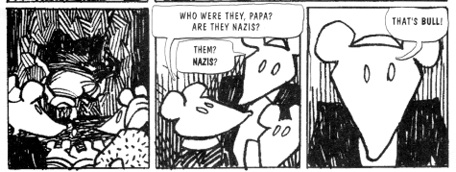
The reader thus has to cope with the father’s hopeless gaze while this comparison has time to sink in, even if it is a little attenuated by the use of this pun.
The second, “Lonesome Dove," is an autobiographical work, featuring Fink the main character and as cynical allusion to the symbol of peace in the guise of an anthropomorphic and portly dove, who reflects about the conflict while sitting at his desk and inking his drawings.77 As a diversion, the Fink-dove turns on the radio and is confronted immediately with the breaking news of a terror attack.78 Fink then depicts his inner conflict concerning the external, Arab-Israeli, conflict: although Fink supports the Palestinian cause, he cannot but condemn Palestinian terrorist attacks.
This depiction of Fink’s inner turmoil is also the subject of Israël-Palestine, an autobiographic graphic novel, featuring himself (this time as a human) and his family. In it, he recounts several personal memories from different periods of his life. At times, these memories are intercut with funny double-pages, explaining Israel “for dummies.”79 In the memories-chapters Fink is, again, very self-critical. For example, he is narrating a childhood episode in which he naively used the Hebrew derogatory term for Arabs, “Arabouchim." He did not question the term at the time, as it was “said by all kids.”80 In other chapters Fink explains that during his time in the army he tended to see the Arab-Israeli conflict in black and white, the Palestinians being the “good guys” and the Israelis the “villains”81 but that since being a father, especially during and after the second Intifada, he started to see things as being a bit more nuanced, condemning terrorism on both sides. The chapters “Panna Cotta” and “Les Fink Combattent le Terrorisme” are particularly powerful as while the latter depicts the Fink-family but also the Palestinians literally as targets,82 the former takes up Israel’s national trauma, the Rabin assassination, and makes tangible the total despair of the leftwing Israelis as to the upcoming end of the peace-making process.83
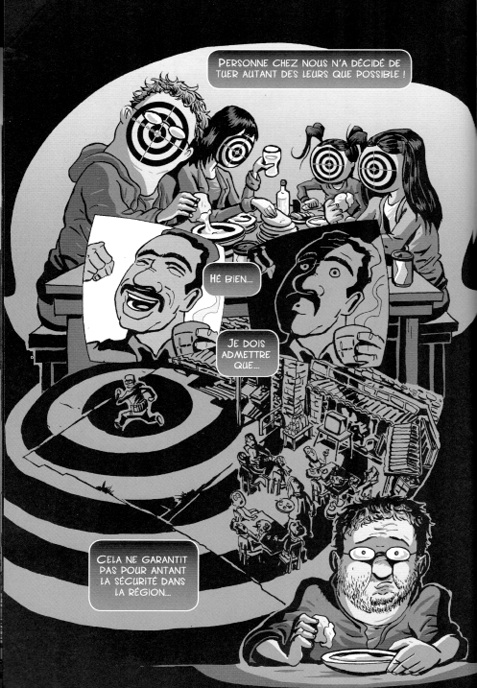
Just like in Fink!/Histoires, Fink thus draws in Israël-Palestine a nuanced, at times self-ironic picture of himself as a leftist comics author who is supporting the Palestinian cause, but who condemns the extremists. Both books contain therefore a peace-building message.
However, even though Fink is the most prominent Israeli comics author and that the two discussed comics are inscribed both into the tradition of Jewish humor and Israeli sarcasm,84 their messages seem to remain not to have been received by most of the Israelis and Palestinians, as only one of them has been published in Hebrew and neither in Arabic. Moreover, as there does not exist an English translation of Israël-Palestine (according to Uri Fink, no editing house is interested in publishing this work),85 the readership of these two comics is reduced to a very small audience, which really has to be interested in that kind of comics, as they are neither advertised nor easy to find.
Galit and Gilad Seliktar
Fortunately, this is not the case of Farm 54, which has been published in Hebrew and English and other languages after its first publication in French in 2008.86 It is the first comic book which Gilad Seliktar (born 1977) made together with his older sister Galit. As with Fink’s work, it is (partly) autobiographical;87 the artwork however, and especially the elliptical yet atmospherically very dense narration, make it totally different. Also, the references to the Arab-Israeli-conflict are not as homogenous and direct as in Fink’s works; they are much subtler and heterogeneous, increasing from chapter to chapter. This is surely due to the fact that the book is a literary adaptation of three short stories by Galit Seliktar,88 but it is also due to the structure of the book, which recounts, in chronological order, episodes in the life of an Israeli girl/young woman named Noga, who becomes increasingly aware of the conflict as she grows older. The first two episodes, an untitled one and “The Substitute Lifeguard," do not contain any noticeable allusion to Israel, despite the character’s names. The second, “Spanish Perfume 1983," contains several small hints of the Arab-Israeli conflict through allusions to the First Lebanon War.89 One should also mention that in this chapter the Arab-Israeli-conflict as a whole is still of marginal importance to the teenage Noga and her friends. In the last chapter instead, “Houses 1989," which, according to Galit Seliktar, is the most autobiographical of the three,90 Noga’s understanding of the conflict changes dramatically as she becomes sensitive to the attitudes of Israelis (civilians and military alike) towards the Palestinians.
In the first section of this chapter, the young woman is working in an egg-farm together with employees from Gaza, who are constantly scolded by the female forewoman, Tamara. That supervisor does not appreciate that Noga is talking to As’ad, a good looking Gazan.91 Later when Noga leaves the farm because of her military service, Tamara bids her farewell with a remark that is heavy with meaning in this context: “You’ll take good care of As’ad’s mates, ah?”92 As’ad, on the other hand, shows his affection to the Israeli girl by offering her (for her time in the army) an audio cassette with music by Umm Kulthum, Egypt’s most famous singer and national symbol.93
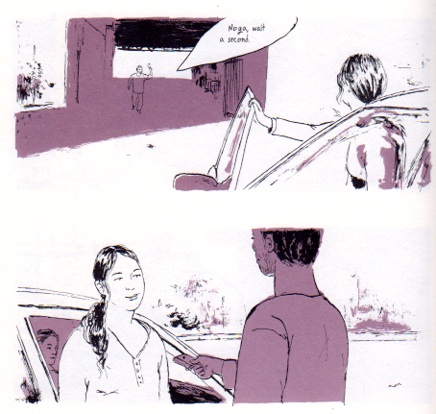
Kulthum’s name is written in Arabic on the tape. This information, however, is not revealed to every reader because an explanation on the bottom of the page, which can be found elsewhere in the comic in regards to Jewish holidays for example, is missing.94 (In addition to that, music tapes are nowadays on the way of becoming a technical relic and have to be identified as such by the reader.)
Noga’s mother doesn’t seem to be happy about her daughter’s contacts with a Palestinian man, either. This is made tangible by means of a series of textless panels, depicting the woman silently chain smoking in the car with Noga at her side after she has witnessed As’ad giving her daughter the tape. The final panel of this wordless, atmospherically very dense sequence depicts the car driving through the rain with cigarette smoke escaping through Noga’s window.95 Her mother’s wordless chain smoking (which clearly bothers Noga judging by the look on her face) thus becomes an allegory of her different points of view in regards to the Palestinians and the Arab-Israeli-Conflict.
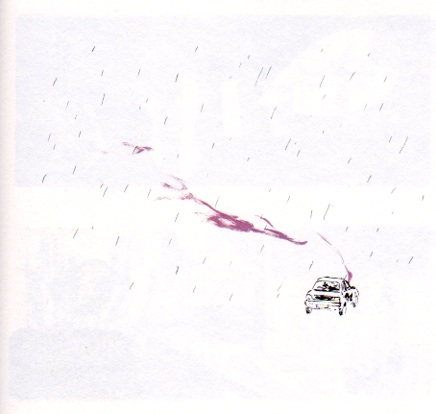
The second half of the chapter illustrates Noga’s military service in the occupied Palestinian territories (oPt). On her first night during which she was listening to Umm Kulthum, she has to replace a female soldier to be present at a compulsory evacuation of a Palestinian house. The narration of the operation is very troubling, as it reveals the rather carefree attitude of the soldiers: non-commissioned officer Efrath is only concerned with her own attractiveness and the predominantly male soldiers regard the nightly operation as a game. In the beginning of this sequence, Noga is still visible in the panels. Then, the perspective changes abruptly to her point of view as a soldier asks her if she can see the village. All the following panels depict Noga’s point of view, as she is witnessing the evacuation and as she is observing Efrath, who doesn’t seem to care about the evacuation at all. The sub-officer sits through it, holding a little rabbit on her lap. At dawn, the evacuation is complete and the combat engineers start mining the house. Meanwhile, Noga observes a “plump pigeon” – a sarcastic symbol of peace in this context - on the roof of the vacant house.96 The dove flies away together with other birds and the story ends, after a sketchy drawing of the house beneath a bleak sky, followed by a panel left totally blank, thus anticipating the upcoming explosion that will leave a blank spot where the houses once stood.
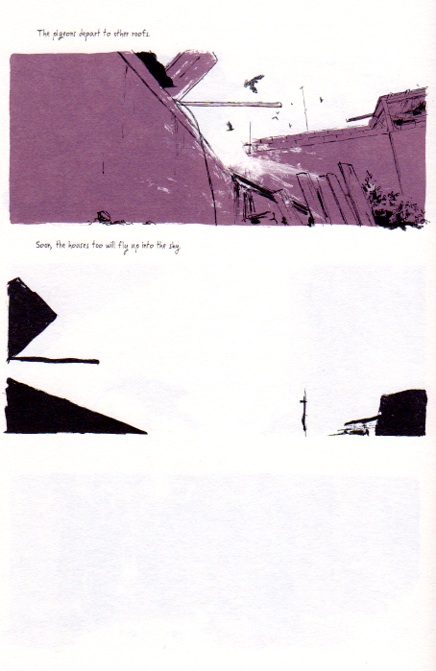
The mise-en-scène of changing perspectives is remarkable, since it underlines the heroine’s mental detachment from mainstream Israeli thinking: she is obliged to be present at the expulsion and demolition of the houses but doesn’t approve of it. Even if Galit Seliktar thinks retrospectively that Noga’s (i.e. her own) “decision to obey such orders with little protest is almost as harmful as keen participation,”97 the graphic novel nevertheless promotes very effectively the questioning of Israeli politics and an understanding for the Palestinians. The peace-building message is furthermore enhanced by the fact that the Palestinians are depicted in the same way as the Israelis. This omission of stigmatizing and/or stereotyping brilliantly communicates that Israelis and Palestinians are equal. In addition, the music tape, even if the reader could not identify it as an Umm Kulthum cassette, symbolizes Arabic music; an acknowledgement of the Arabic contributions to humanity’s culture and the arts.
BACK
Palestinian Contributions to Peace-Building
Samir Harb
While on the Israeli side contributions to peace-building within the corpus of AIC-comics are still scarce, they seem to be even scarcer on the Palestinian side. Initially, this scarcity was possibly due to cultural and religious constraints, but today, it is probably due to the restricted possibilities for studying graphic art in the oPt and also due to distribution difficulties which make it virtually impossible, even for talented artists, to make a living from their art. One solution for the Palestinian artists is, therefore, to become a newspaper cartoonist (as was Nadji al-Ali98) or to be a comics artist only as an amateur. Samir Harb is (still) the latter and works for a living as an architect.99 As drawing is his passion and he is convinced that comics is a useful means for political and social criticism, Harb, born in 1981, co-founded the (now stopped100) comics magazine Oba’den with a couple of friends. They managed to publish two issues at a rate of 50.000 copies each which they distributed for free in the Gaza strip and the West Bank (10.000 and 40.000 copies respectively).101 Furthermore, he uses the internet as a channel for the distribution of his work by means of his personal weblog CoPYLeft and other websites,102 which makes it - in theory - accessible not only for Palestinians, but also for an Israeli readership.
The work itself consists of short stories in Arabic and English that are mostly drawn in black ink with scattered red colorizations. All stories focus on the daily problems and struggles of the normal Palestinian people. However, their main objective seems not to criticize Israel, but to criticize internal Palestinian problems, mainly the political division of the Palestinians into Hamas-ruled Gaza and Fatah-ruled West Bank. The comic Oba’den No. 2103 for instance, starts with two Palestinians talking in a café about the division of the Palestinian government. Behind them one can read on a blackboard a public invitation for national reunion. Against the background of the 2008 ceasefire between ‘Hamas’ and Israel, the man on the right is smiling confidently, expressing his hope of a political reunion of Palestine and the end of the occupation thereafter. All of a sudden, he is severely wounded at his head by a bullet. He then is transported in an ambulance which has to pass a checkpoint to access the hospital. But at the checkpoint the man dies as Israeli soldiers do not allow the ambulance to pass because the crossing permit is missing.
The following pages display the discussion about the death by representatives of ‘Hamas’ and ‘Fatah’ and of ordinary Palestinian citizens. Whereas a representative of the ‘Fatah’ (distantly resembling Mahmoud Abbas without glasses) expresses his confidence in an upcoming solution for the checkpoint-crossing of ambulances, a representative of ‘Hamas’ (who resembles Mahmud al-Zahar) does not comment on the crossing problem of the checkpoints itself; instead he reminds the people to avoid cafés, as they are too dangerous.104 The ordinary Palestinians, on the other hand, gossip and speculate about the reasons for the shooting: some think that the victim might have been a spy, others spread the rumors that he must have had problems with his wife, or debts.105 At the end, the man who has witnessed the shooting of the victim, hastens home to lock out all this gossiping and weeps bitterly in his woman’s lap, wishing only to sleep and dream.106
Of course, the problem of checkpoints is the subtext of the story, but Harb does not openly judge or condemn their existence; he rather criticizes the bureaucratic and arbitrary regulations of the crossing. His main focus however, is to display and condemn the attitude of the common people who prefer to rack their brains about possible personal reasons for the shooting instead of possible political ones, who avoid discussing the problematic issue of the checkpoints, and who are, in general, not willing (or able to) act in concert and fight for a political reunion of the two Palestines.
This equally critical view of the Israeli and Palestinian politics is furthermore underlined by the drawings, as Harb, just as Seliktar or Fink, does not stigmatize the Israeli characters by means of stereotyping, but treats them just the same as the Palestinian characters. He does not depict the IDF soldier in the third panel of the second page with nice features (but makes him, on the contrary, a little plump and dumb looking). However, neither the victim nor the other characters of the story (e.g. one is spitting in his excitement of being able to chitchat107 - are drawn as handsome.
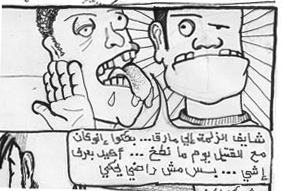
In another one of his short works, From the Diaspora to the Diaspora,108 a non paginated webcomic published as a continuous, vertical strip, the focus is not on the ‘Hamas’-‘Fatah’ power play, but on the complicated issue of construction in the West Bank since its division into Areas A, B and C after the Oslo II accords: a Palestinian couple from the U.S. wants to build a house for their children in Battir, their native village. As there is no other terrain left, they have to accept a construction site on the border to Area C (which is under Israeli security and civil control). The architect places the house in Area B but its balcony protrudes onto Area C. He thinks that this will remain unnoticed by the administration, but is mistaken. The story of the house is made public on television by ‘Regavim,’109 a “peculiar [Israeli] human rights association”110 which proclaims that the house has been entirely built on Area C and demands that it is demolished.111 While the world collapses for the owner, who is informed by phone about the threatened demolition,112 the construction supervisor meets with members of the Palestinian authorities to discuss the issue. There, he learns of a fundamental problem: everybody uses different maps, and for “the PLO, the issue of Area A-B-C expired after five years from the signature of the Accords," as they considered the Oslo II accords only to be interim.113 The webcomic – which is based on a true story114 - ends with a series of panels showing maps of different scale of the concerned area, thus leaving the end of the story open. This end of the narration is quite realistic; indeed, the issue of this house is still unfinished too, still in “a procedural phase at the Supreme Court.”115 Instead of anticipating the Israeli jurisprudence by illustrating the demolition of the house which could provoke strong anti-Israeli feelings in the reader, Harb chose to end the narration by making a philosophical statement, pointing out that while on the maps the thickness of the (border) line always remains unchanged, it certainly does change in reality.
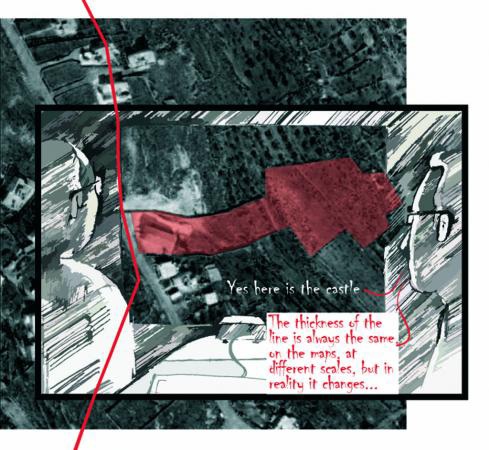
In that way, the comic does not openly condemn the Oslo II accords’ division of the territory of the West Bank, but also criticizes the organization ‘Regavim’ that systematically conducts field surveys to document and record any possible Palestinian trespass into the territory under Israeli control, filing petitions for demolishing Palestinian houses on that land.116 The comic can also be read as a critique of the Palestinian Authorities: they are represented as unable to provide themselves with valid maps and thus help the Palestinian population to deal with their heavy construction struggles.
Silent Night, another example of Harb’s works, has a very metaphysical and religious tone and is therefore entirely different from his other comics.117 It narrates the story of a light coming down to the city, right onto Ramallah’s center junction, Al-Manara square. The light connects with the center pillar of the monument which is surrounded by four lions, and in its midst appears a fifth lion. This fifth lion, either referring to the former monument which consisted of five lions, or symbolizing “pride and power” as do the other four,118 then talks to numerous faceless Palestinians, asking them to release their dreams so that he, the lion, can take them up to “a higher place, a place with hope."119 On the second page, Harb quotes “no one dreams for another” the first line of a poem by Palestinian national poet Mahmoud Darwish,120 who was very critical of the Israeli occupation, and of the Palestinian Authority’s leadership too. What follows is an enumeration of these dreams: dreams of a place that is “secure,” “better” and “warm,” of “peace,” “freedom,” “love,” “hope,” “harmony,” “unity,” “safety”; dreams in other words, that are not specifically Palestinian, but universal.
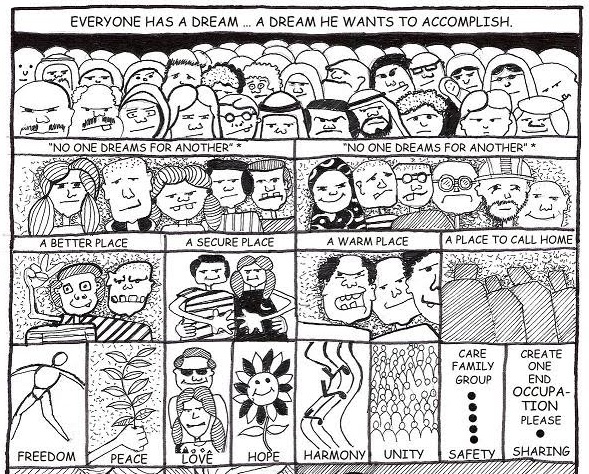
See also http://c-left.blogspot.de; http://www.c-left.blogspot.de/search
Only the dreams of the “end [of] occupation” as well as that of “a place to call home” directly refer to the Arab-Israeli conflict. A dream like the destruction of Israel, on the other hand, is not mentioned in the comic. The choice not to include this dream, and of not raising topics such as the lack of security (which can be read as a critique of the Palestinian government), and the quote by Darwish, clearly make this comic a contribution to peace-building.
A last very interesting example of Harb’s work is Digging for Gold, that criticizes the work of NGOs in Palestine.121 It is the story of a Palestinian man who wants to kill his numerous children by burying them alive as he doesn’t have any work and no money to feed and dress them. When he starts shoveling earth upon them, he is handed a cola bottle down from a military helicopter and is instructed to rub it, at this will help him resolving his problems. The man is very confused but decides to give it a try. To his great surprise, a jinn suddenly emerges from the bottle that strongly resembles Uncle Sam of the well known army recruitment poster by James Montgomery Flagg, but which makes one think of Moshe Dayan as well, as he is wearing an eye patch across his left eye.122 However, the jinni is not helping. Instead, he asks the man to look at the situation at a different angle and to grab the opportunities that lie within the NGOs: “imagine… cars… money… N.G.O. … Castle… Leadership… Bank Accounts…”123
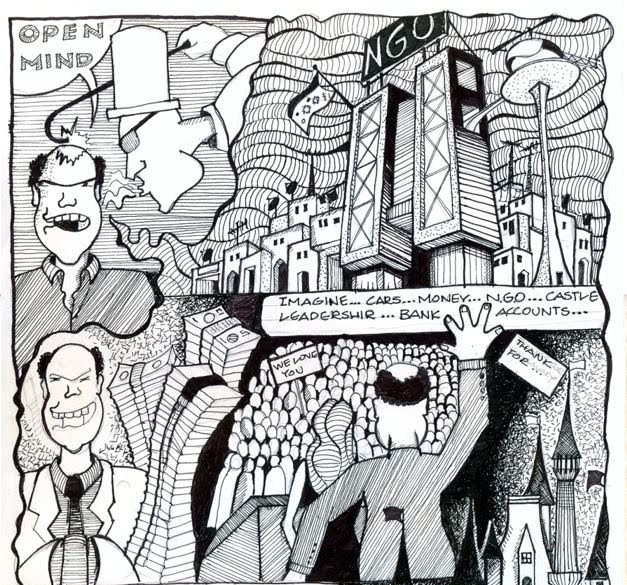
But the man resists this temptation, stuffs the jinni back into his bottle and kicks it away, saying that for the Palestinians, “it is time to find their own path” and that he refuses “all form of colonization.”124 Encouraged by his own strength, he then unburies his children and leads them home, determined to find a way for a better future.
Indeed, the problems of peace-building Palestinian NGOs in particular, but also NGOs in general, described in some literature as “self-righteous at best, elitist at worst”125 have been already critically analyzed by Benoît Challand and other researchers.126 However, such a critique of the work and the functioning of Palestinian NGOs is unique in the comics that contribute to peace-building within the corpus of AIC-Comics and among AIC-Comics in general.127 In this comic, again, Harb thus does not openly criticize Israel but chooses to bring up a painful subject of the power play, corruption and other problems inherent of Palestinian society.
BACK
Conclusion
It’s not for nothing that the proverb says: ‘one picture is worth a thousand words’. Indeed, as the examples that I discussed in this paper show, the works and images of some Israeli and Palestinian comics authors possess an inherent power to transmit peace-building messages. This is because, among other things, drawn images are generally perceived to be less ‘realistic’, and can therefore appear to be less direct, offensive and/or hurtful than the cinematic/photographic images. Drawn images also help the (adult) reader to become aware of the creative process of their making. This fact could help to accept and ‘digest’ the information as more personal, and therefore as more trustworthy.128 Moreover, comics trigger imagination, as “the action between the panels must be filled by the reader.”129 Learning appears to be more effective when imagination is used.130
Comics contain a great potential which has already been acknowledged by different governments and/or institutions and by schools, where comics are used as educational and conflict resolution/peace-building tools.131
However, why has this not been the case in Israel or Palestine? Here are some suggestions, which appear to be intertwined.
First, up to the present day, there is neither a significant comics’ culture nor a large comics’ market in Israel and Palestine; in order to survive, authors have to create groups such as ‘Actus Tragicus’ which tries to sell their work outside Israel or draw for newspapers and magazines.132 The profession of comics’ author and the production of comics are henceforth neither an easy task, nor a fruitful business in this region of the world. Second, possibly because the comics’ culture is so small both in Palestine and Israel, comics with peace-building features are not financially and/or ideologically supported by external institutions. Third, this lack of financial support for peace-building comics is maybe also due to the lack of academic research that addresses the question of the efficiency and educational potential of comics. It has yet to be scientifically proven that comics can have a significant positive and lasting educational effect on their readers.133
Finally, as stated in the introduction, most AIC-comics are either pro-Palestinian or pro-Israeli. As they do not offer a balanced view of the conflict and tend to neglect the other side, they contribute to an entrenchment of the conflict rather than to peace-building. Apparently, neither the great majority of the authors living inside Israel/Palestine, nor the ones living geographically (and culturally) outside of this conflict-area, seem to be willing to produce comics that could contribute to peace-building or are capable of it. As it is, AIC-comics are unfortunately mostly used as a ‘cultural weapon’ against the other side.134